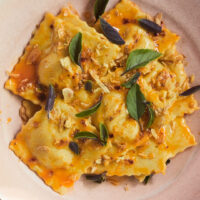One of the most significant changes to our lives over the years has been evening activities with our child, which has meant less time for making dinner. While it’s been a shift, I’ve come to rely heavily on filling items that freeze well, including dumplings, soups, and filled pasta such as this kabocha ravioli.
Kabocha Ravioli, a Friend to Butter
Whenever I turn to butter as a sauce, I steer away from ricotta and into vegetable-filled pasta. This way, the richness can come from the sauce, and the filling is a companion rather than overwhelming in heaviness. Of course, you can easily use cheese ravioli and finish the dish with more vegetables.
Bulk up the vegetables and greens
Regarding what goes well with this kabocha ravioli and butter combination, I recommend blanching greens such as spinach or kale and toss in at the end. Alternatively, extra roasted squash would be a nice touch as well.
Beyond the greens and squash, I always like to serve dishes like this with a punchy salad that is big of acid. This way you get extra vegetables and a nice balance with the richness of the pasta.

Ravioli, homemade or store-bought
Given my novice pasta-making, I appreciate others’ in-depth information about making and shaping pasta. I love Meryl’s ravioli 101 post, which I highly recommend reading before diving into this homemade kabocha ravioli.
Also, I can’t stress this enough: store-bought ravioli works well with this recipe and keeps it super simple. You can often find pre-made pasta in refrigerator cases, or if you have a larger farmers market around, I feel like there’s always someone selling fresh pasta.
Make it Vegan
Luckily, these days, companies like Miyoko’s make a decent vegan alternative to butter, which works great as a compound butter base. Then, for the pasta and filling, use an eggless pasta dough and replace the mascarpone cheese with a bit of vegan cream cheese or leave it out altogether- it’s still the kabocha ravioli, just vegan!
Kabocha Ravioli with Chile-Lemon Butter
This kabocha ravioli is a hearty fall pasta that takes a bit of time but can easily be made in advance and frozen for future meals.
- Yield: Up to 4 servings 1x
Ravioli
100g all-purpose flour
25g white wheat flour
100 grams liquid: roughly 1 egg, 2 egg yolks, and enough olive oil to bring it to 100g
100g mashed kabocha squash
30g mascarpone cheese
½ teaspoon kosher salt
For Finishing
1 recipe for chile-lemon butter
Basil for serving
Crispy shallots for serving
Instructions
- To make the ravioli: place the flours on a clean, flat surface. Place the eggs/olive oil in a well in the middle. Whisk eggs and slowly incorporate the flour using a fork and bench scrapper. Keep mixing, and once the dough starts to form, switch to your hands and knead the dough until the dough is smooth and no longer sticky (but not stiff). Add more flour as needed to reach this feeling. The dough should spring back when pressed. Form it into a disk, cover it with a damp towel, and let it rest for 20 minutes.
- To make the filling: combine the squash with the mascarpone and salt, whipping together until as smooth as possible. Transfer to a piping bag or have a spoon ready.
- Divide the dough into 4 pieces. Flatten the dough with your hands, working with one piece at a time and keeping the rest covered. Coat the pasta in a bit of flour, then use your chosen machine to roll the pasta into sheets until you reach the desired thickness–I use a Marcato Atlas to a 7. I also recommend reading this ravioli 101 post to help with this step!
- I prefer smaller, 2″ ravioli, which allows me to work with one sheet and fold over. I also like to mark where the filling will go with the back of a 1″ biscuit cutter. Pipe or spoon the filling into each space, fold over the dough, press down again around the filling with the back of the biscuit cutter, then cut out each square (see the video will be helpful!)
- To cook the ravioli: Once your ravioli is ready, boil a pot of salted water and place a few tablespoons of chile butter in a bowl. Add the ravioli to the pot and cook until tender, 2-3 minutes for fresh, 3-4 for frozen.
- Using a spider strainer or slotted spoon, immediately transfer the ravioli to the bowl with the butter. Toss until the butter has melted and coated the ravioli.
- Divide the ravioli into bowls and finish with fresh basil and a sprinkle of crushed crispy shallots.



